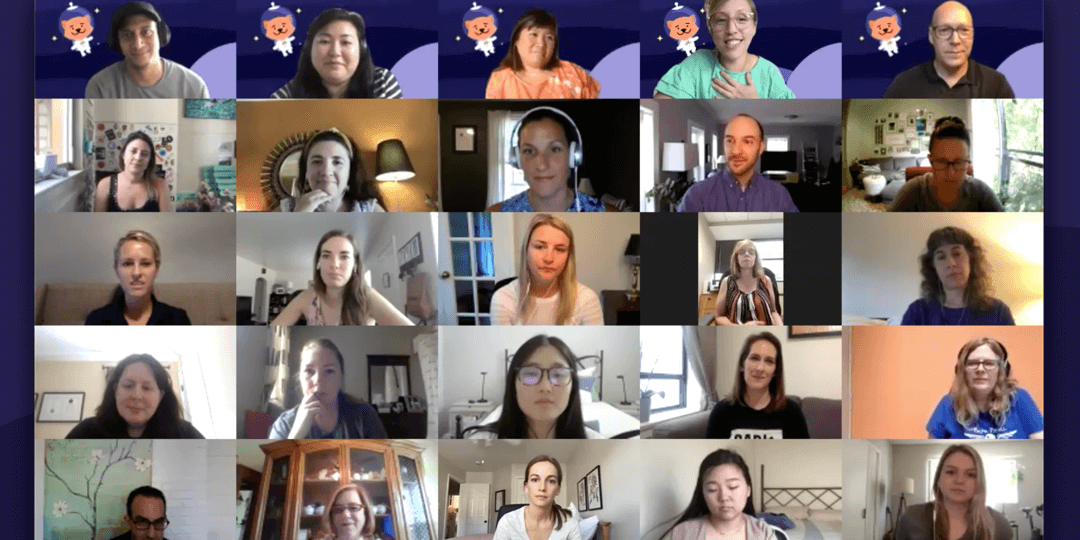When it comes to Human Resources in financial services, there are few areas more important than employee experience. Ensuring that your employees are engaged with their work, satisfied with their jobs, and having a positive overall experience with your organizations plays a crucial role in everything from company culture to employee retention to employee performance. And with so many financial employees leaving their jobs (according to data from the US Bureau of Labor Statistics (BLS), in April 2022, 249,000 people left their jobs in the financial sector), keeping your employees engaged and satisfied is more important than ever.
But you can’t understand what you don’t measure. So if you want to keep employee engagement and satisfaction high at your organization, you need to measure it. Below, we’ll take a closer look at why measuring employee satisfaction is so important for financial services firms — and five ways to do it.
Why Measuring Employee Satisfaction Is Important
“You need to measure employee satisfaction to understand why certain employees are less or more engaged,” explained Sarah Livnat, Chief Human Resources Officer at NorthOne, a company that provides financial tools to small business owners.
High employee engagement can lead to a variety of positive outcomes. According to research from Gallup, organizations with engaged employees have 81% lower absenteeism, 18% higher productivity, and significantly less turnover (18% less for high-turnover organizations and 43% less in low-turnover organizations) than companies with low employee engagement.
But the finance industry is having problems with employee engagement. A 2021 study found that “only 50% of employees in the banking sector are highly engaged and 35% are a retention risk.” This makes measuring employee satisfaction in the financial services sector especially crucial.
Measuring employee satisfaction and experience in financial services gives Human Resources leaders the information they need to gauge how engaged and satisfied their workforce is. More importantly, it enables HR teams to identify changes they can make to drive engagement and job satisfaction and create a more positive experience for their workforce.
5 Effective Ways for Financial Services Companies to Measure Employee Satisfaction
Not only is measuring employee satisfaction crucial in the financial services industry, but how it’s measured is equally important. After all, you want to glean the right insights — the ones your organization needs to improve workplace experience and employee engagement, satisfaction, and retention. Here are five ways to effectively collect the data you’ll need to improve your financial organization.
1. Engagement Surveys
Engagement surveys are surveys that include questions related to employee engagement, satisfaction, and experience. These surveys can provide insights into not only how engaged and satisfied your workforce is, but why they feel the way they do. This information can help you identify what needs to change in order to increase employee satisfaction and engagement.
These surveys can be an effective way to collect quantitative data, which will help you identify the engagement-related issues that need your attention. But they can also be useful for collecting qualitative data, which can give those issues context and help HR craft a better strategy for addressing the problems in a meaningful way.
For example, say you’re sending out a survey to measure your employee Net Promoter Score (eNPS). In an eNPS survey, you ask employees to rate, on a scale of 0 (not at all likely) to 10 (extremely likely), how likely they are to recommend your company to a friend. That’s quantitative data; you can tally the results and immediately identify if there’s a problem. If your eNPS score is a 3, for instance, it’s clear that your organization has a problem with employee satisfaction.
But this doesn’t tell you why the problem exists, which is why you also want to collect qualitative data — like asking employees to write down comments to further explain their answer. This will provide deeper insights into what’s driving the employee dissatisfaction and help you create a plan to solve the issue. If, for example, you find that 80% of employees who chose a score of 3 or below cited lack of work-life balance as a reason for their answer, you’ll likely need an action plan to create a better sense of balance for your workforce.
“An eNPS question…will help you understand how things are changing over time — and the specificity of comments will help leaders create action plans to address issues at the company,” Livnat said.
How often you run employee engagement surveys is also important. “HR leaders in the finance space must…[start] truly listening to how the workforce feels on a more frequent basis,” said Jason Averbook, CEO and cofounder of digital and HR strategy company Leapgen. “We don’t ask our kids once a year how they are doing; we don’t ask our partner once a year how they are,” he said. So why are we only asking our employees once per year?
In addition to less frequent, more in-depth engagement surveys, you’ll also want to send out more frequent pulse surveys — short, one-to-five questions surveys that ‘check the pulse’ of employee engagement at any given time. Pulse surveys can help you gauge employee satisfaction in the moment and identify issues before they become larger problems. And because they’re so short, you can send out pulse surveys as often as you’d like (for example, biweekly or monthly).
Need help crafting your engagement surveys? Download the Lattice Employee Engagement Survey Template.
2. Stay Interviews
We’ve all heard of conducting exit interviews when an employee is leaving the company, but the less common stay interview is another helpful tool for measuring employee satisfaction. Stay interviews are one-on-one meetings between employees and an HR team member (or, in some cases, the employee’s manager). During stay interviews, the interviewer asks the employee questions about their employee experience, engagement, job satisfaction, and anything else that will help Human Resources determine how an individual feels about their job and the company as a whole, and how likely they are to stay with the organization — or look elsewhere for another opportunity.
Stay interviews are important because they give you the opportunity to speak with employees on an individual basis to get a sense of their job satisfaction and engagement. They can also deliver more nuanced insights than surveys typically can; while the questions you ask during stay interviews are often similar (and, in some cases, identical) to the questions you’d ask in a survey, because stay interviews happen face-to-face, you get additional information from an employee’s tone, body language, and other nonverbal cues.
While stay interviews can help obtain invaluable feedback about what needs to change within your organization to improve employee satisfaction, because the employees are current employees — and you want to keep it that way — it’s essential that you take their feedback and act on it. Otherwise, it can make employees feel unheard and discouraged, which can ultimately make them feel less satisfied and engaged.
“Stay interviews are only effective if…the interviewer has autonomy to change or react to the feedback given,” noted Erika Duncan, cofounder of HR consultancy People On Point. “If HR is only collecting information and not empowered to act on it, this tactic often backfires.”
Don’t know what to ask in your stay interviews? Read this Lattice article about 20 questions to ask your employees in stay interviews.
3. Exit Surveys
Stay interviews measure employee satisfaction for team members who still work for the company, but exiting employees can also be a useful resource for understanding satisfaction and engagement within your financial organization. This is where exit surveys come in.
Exit surveys are surveys that HR sends to departing employees to gather insights about their experience with the company and why they’re leaving, and they can be an incredibly effective tool for identifying issues that could be causing employee satisfaction and engagement to drop.
While exit surveys are often used in tandem with exit interviews, the survey format offers some advantages over a face-to-face interview, one being the quality of the feedback. Some employees might feel uncomfortable sharing honest feedback face-to-face with an HR team member during their exit interview. But because they can fill out an exit survey on their own time and from their own computer, often after they’ve left the company, many people feel more comfortable sharing the real reasons behind their departure in this format.
For example, an employee may feel uncomfortable telling HR that their manager treated them poorly, particularly if that manager is sitting in on the interview. But it might be easier for them to share that information through a digital survey.
Another advantage is that surveys make it easy to quantify your data, which can enable you to track trends and identify issues that are causing your employees to leave. For instance, on your exit survey, you might ask exiting employees to list the top three reasons they’re leaving the company. If 90% of departing team members include “toxic company culture” on their list, you know you need to make some significant culture changes at your financial firm to increase employee satisfaction and keep your best people with the company.
“Exit surveys can be helpful to pinpoint specific deficiencies in management and leadership and overall culture,” Averbook said. Once you’ve pinpointed those weak spots, you can work to change them — and increase employee satisfaction in the process.
Not sure what to ask your employees on their exit survey? Download Lattice’s Employee Exit Survey Questions Template.
4. One-on-Ones
“One-on-ones allow for intentional outreach where [managers can celebrate] progress, listen to feedback, and follow through to remove hurdles,” said Duncan. These meetings are crucial for fostering strong relationships between managers and their direct reports, but they’re also an essential tool for measuring employee satisfaction.
“Continual one-on-ones…can truly help managers and HR leaders better understand employee satisfaction,” Averbook said.
When managers meet one-on-one with their employees on a regular basis, they can stay up-to-date with how their direct reports are doing and how satisfied they are with their jobs. This can help them catch potential employee engagement issues early and develop a plan to resolve them.
Say you have a top performer who’s dissatisfied with their current job responsibilities. If that employee is having one-on-ones with their manager regularly, chances are, they’re going to bring up their dissatisfaction and the manager can do something about it. For example, the manager could assign them to a different project or give them new tasks to work on that better align with their goals. On the other hand, without these regular one-on-ones, that employee might never speak up. Instead, they could get progressively more and more dissatisfied with their job until they leave for another opportunity.
In order to use one-on-ones to measure employee satisfaction, “the key…is to effectively ask questions [and] have remarkable listening skills,” said Averbook. Coach your managers to ask deep questions about their employee’s experience at work; how engaged, happy, and satisfied they feel; and what is (and isn’t) working for them. Then, really listen to what they have to say.
Managers should then take that feedback and use it to improve their direct report’s experience and job satisfaction. If an employee shares that they’re unhappy because they feel like they’re not growing professionally, for instance, you might have the manager work on a development plan with their employee that outlines exactly what they need to do to land a promotion or otherwise grow within the company.
Need help maximizing your one-on-ones? Download Lattice’s Manager One-on-One Agenda Template.
5. Upward Reviews
An employee’s experience with their manager, supervisor, or leadership team can have a significant impact on their overall satisfaction at work. So in order to get a full picture of employee satisfaction at your organization, you need to find out how your employees feel about the people managing them.
Upward reviews are like employee performance reviews in reverse; they give employees an opportunity to share feedback about the people above them (like their direct manager or department head), including what they’re doing well and, more importantly, where they could improve.
By giving employees the chance to provide honest feedback about any challenges they’re having with their higher-ups, HR can identify how and where those difficulties are contributing to employee dissatisfaction — and then take steps to address them.
During the upward review process, if, for instance, you have 10 employees share feedback that the finance manager doesn’t respect their time and contacts them with work requests on nights and weekends, it’s fair to assume that the lack of work-life balance is causing engagement and satisfaction issues with those employees. To remedy this, you might invest in training the manager in question on having better boundaries around work time and respecting workers’ free time.
Leaders and managers can be a major contributing factor in employee dissatisfaction, and upward reviews are a useful tool for measuring the impact, both positive and negative, of leaders at your organization. As a result, you’ll be able to put plans in place to address any management-related employee satisfaction issues.
Need inspiration for the best questions to ask during upward reviews? Download Lattice’s Performance Review Question Bank Template.
—
Like many sectors, the financial services industry is currently facing serious challenges keeping employees engaged, satisfied, and committed to their jobs. While some of these difficulties are due to the broader climate and some are industry-specific, measuring employee satisfaction is a crucial step for combating all of them. The expert strategies highlighted in this article will give HR the tools they need to track how employees are feeling about their jobs, workplace experience, and organization as a whole. Human Resources can then use that information to address any employee satisfaction issues — before they progress and prompt anyone to leave the company.



.jpg)



